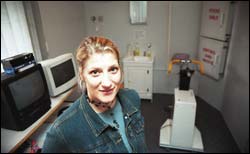Sports scientists offer one-day Big Sister breather
11 August 2004
Big Sister: Dr Lara Keytel in the metabolic chamber where she hopes to determine the metabolic rate of a group of African and white women.
Fancy a break from the day-to-day drudgery and routine, tucking away at some gratis Woollies goodies and, for good measure, doing your bit for science? Well, if you are an African woman or a white woman and have a body mass index of 30 or over (see box below), then Dr Lara Keytel of the MRC/UCT research unit for Exercise Science and Sports Medicine (Essm) may have just the 24-hour getaway for you.
Keytel and dietetics honours student Ronit Cohen - along with colleagues Courtney Jennings and Yael Joffee, and Drs Julia Goedecke and Malcolm Collins - are running a project in which they want to scrutinise the how and why of obesity. To do so, each is tackling the problem from a different angle. There is a common denominator in their respective studies, however - all are concentrating on the differences in obesity among African and white women, taking into account the interplay between genetics and environment, says Keytel.
Of interest to the scientists is the possible link between types of obesity - the kinds and distribution of fat - and the different diseases that afflict the two groups of women. It has been shown that black women are more susceptible to diabetes and cardiovascular disorders, white women to hypertension and strokes. "We're trying to build a big picture of why we have different types of obesity, and whether the different kinds of obesity can be linked to the different kinds of diseases."
For their study, Jennings and Joffee are genotyping blood samples from some 500 women from the two groups, investigating the genetic triggers associated with obesity and its associated health outcomes. In turn, Goedecke is focusing, in particular, on the distribution of body fat and the metabolic behaviour of body fat in specific layers - superficial and deep to the skin, and the body fat concentrated around the internal organs.
For their contribution, Keytel and Cohen are taking another tack - they're looking at the metabolic rates of the two groups. A US study has found, explains Keytel, that all things being equal, African American women have a lower at-rest metabolic rate than white women. Meaning that African American women burn fewer calories at rest.
To see if the same holds true for African and white women in South Africa, Keytel hopes to measure, as accurately as possible, the metabolic rates of a group of around 60 women, some lean, most obese. And while there is a mixed bag of metabolic-rate calculations available - Keytel came up with a few novel ones of her own for her doctoral studies - the best way to pin it down is to closet a subject in a tailor-designed "metabolic chamber" for 24 hours. "It's the absolute gold standard of metabolic measurement," says Keytel.
The only snag for Keytel was that there were no metabolic chambers in South Africa or, for that matter, the entire southern hemisphere. Until she built one as part of her doctoral work, that is. In fact, her supervisor, Associate Professor Vicki Lambert, insisted that Keytel finish the chamber before she signed off on Keytel's PhD (Keytel graduated in June).
Keytel, working off little more than e-mailed instructions from Paul Schoffelen, an engineer at the University of Maastricht in Amsterdam, Holland, had to build and assemble the facility and equipment from scratch. Willem Krige of Cape Technikon, using LabVIEW software provided by National Instruments South Africa, developed the intricate software to run the chamber.
Housed in a lab in Essm's quarters at the Sports Science Institute of South Africa in Newlands, the metabolic chamber is one of only 18 or so in the world. It is also, as pointed out above, the only one in operation in the Southern Hemisphere (eat you heart out, Australia).
The facility is airtight, and by controlling the amount of oxygen pumped into the chamber and measuring how much escapes via a vent, the researchers can see how much oxygen the subject uses over the 24 hours (the difference between the amount of oxygen going in and oxygen going out). Once researchers have pinned down the amount of oxygen used, it's easy to calculate how many calories the subject burned (people spend an individual-specific amount of calories for every litre of oxygen consumed) and thus derive the metabolic rate, that is, the rate at which the body uses energy.
A subject's 24-hour stay kicks off at 17h00 in the evening (this is preceded by a dietary analysis so subjects can be fed meals that closely match those normally enjoyed). After some tests, the subject enters the one-room chamber at 18h00. The following 23 hours follows a strict routine - there are regular meals, courtesy of Woolworths, two gentle half-hour training sessions, and plenty of free time for watching videos or television, reading the magazines that are provided, catching up with the family (cellphones are allowed) and surfing the Internet. Meals are passed through the first of two special portholes, and waste (leftovers, fresh urine samples, number twos) is picked up through the second.
And despite the Big Brother setting - or Big Sister, as the researchers have it - privacy is guaranteed as Keytel, who bunks down next to the chamber and is within intercom-reach for the duration of the trial, keeps strict - often harsh - watch over access to the lab.
A good eight-hours' beauty sleep is also on offer - lights go out at 22h00, reveille is at 07h30. "It's like a holiday," says Keytel.
And science is served, of course.
 This work is licensed under a Creative Commons Attribution-NoDerivatives 4.0 International License.
This work is licensed under a Creative Commons Attribution-NoDerivatives 4.0 International License.
Please view the republishing articles page for more information.










